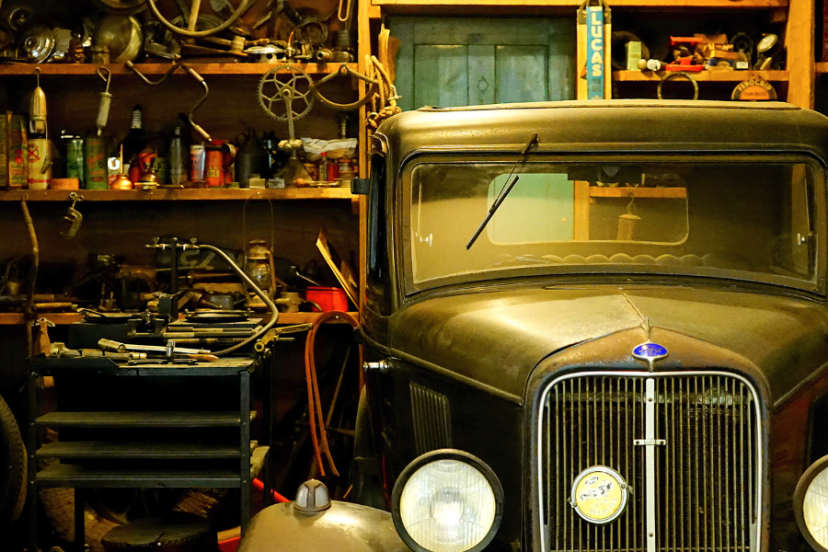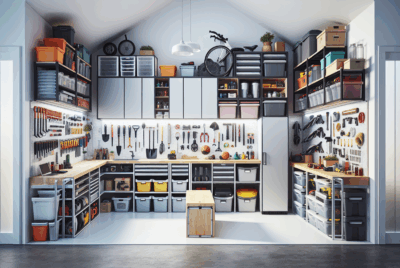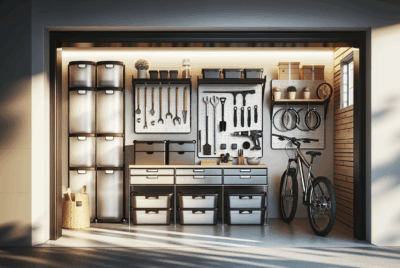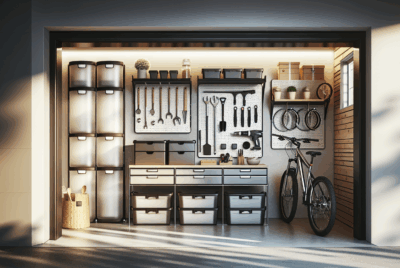How To Cool A Garage: Top Tips for Summer Comfort
As an Amazon Associate, I earn from qualifying purchases, at no additional cost to you. Disclaimer
In the midst of a scorching summer day, I know just how unbearable a hot garage can be. Trust me, I’ve been there. Sweating profusely while trying to sort out old stuff, or fix your car can be quite a task. This is why I set out on a mission to learn and share with you the most efficient ways to cool a garage. This insightful article is a collection of cost-effective and practical strategies that I’ve tried and surely worked. From Proper insulation to the use of fans and air conditioning, these tips and tricks will transform your steaming garage into a pleasantly cool space.

Understanding the Need for a Cool Garage
Gone are the days when a garage was merely a place to park your car. In our modern era, the garage has evolved into so much more. It’s a workspace for DIY projects, a storage area for seasonal items, and sometimes, it’s simply a cool retreat from the summer heat. But why exactly do we need to keep our garages cool?
Can a hot garage damage your car
Let’s begin with the most traditional function of the garage – vehicle storage. If you’re like me, your car is a precious investment, and just like any investment, it needs protection. Prolonged exposure to high temperatures can wreak havoc on your vehicle. Heat can cause motor oil and other fluids inside your car to break down more quickly, directly impacting the vehicle’s performance and longevity. Moreover, excessive heat can damage your tire pressure, battery life, and even the interior of the car, especially if it’s leather.
Benefits of a cool garage for personal comfort
Now, let’s consider comfort. A cool workspace can increase productivity, so if you use your garage as a workshop, keeping it cool is essential. Higher temperatures can also pose health risks, ranging from mild dehydration to serious cases of heat exhaustion. Therefore, having a cool garage is not just about comfort, but also ensuring your safety while you’re in there.
Utility of the garage as additional living or storage space
Finally, many of us use our garages as an extra storage or living space. Things like electronics, wooden furniture, or other temperature-sensitive items need a cool, dry environment to avoid damage. In terms of livability, a garage that stays cool can be an excellent spot for a game room, gym, or home office.
Assessing the Current Temperature of your Garage
Before we spring into action and start cooling down our garage, it’s crucial to assess the current temperature accurately.
How to take accurate readings
To get an accurate reading of your garage’s temperature, invest in a good quality indoor/outdoor thermometer. Position it in your garage, ideally in the middle and away from direct sunlight, and monitor it for a few days to get a genuine feel for the average temperature.
The best times to take temperature readings
For a comprehensive understanding of your garage’s climate, note the temperature at various times of day – morning, afternoon (when heat is typically at its peak), evening and late at night. This process will give you a clear idea of how the temperature fluctuates and when it hits maximum levels.
Understanding the factors that affect garage temperature
Several factors can affect your garage’s temperature – direct sun exposure, insulation, ventilation, the weather outside, and even appliances stored inside that generate heat. Having a grasp of these factors will not only help you understand why your garage heats up but will also present solutions to the problem.
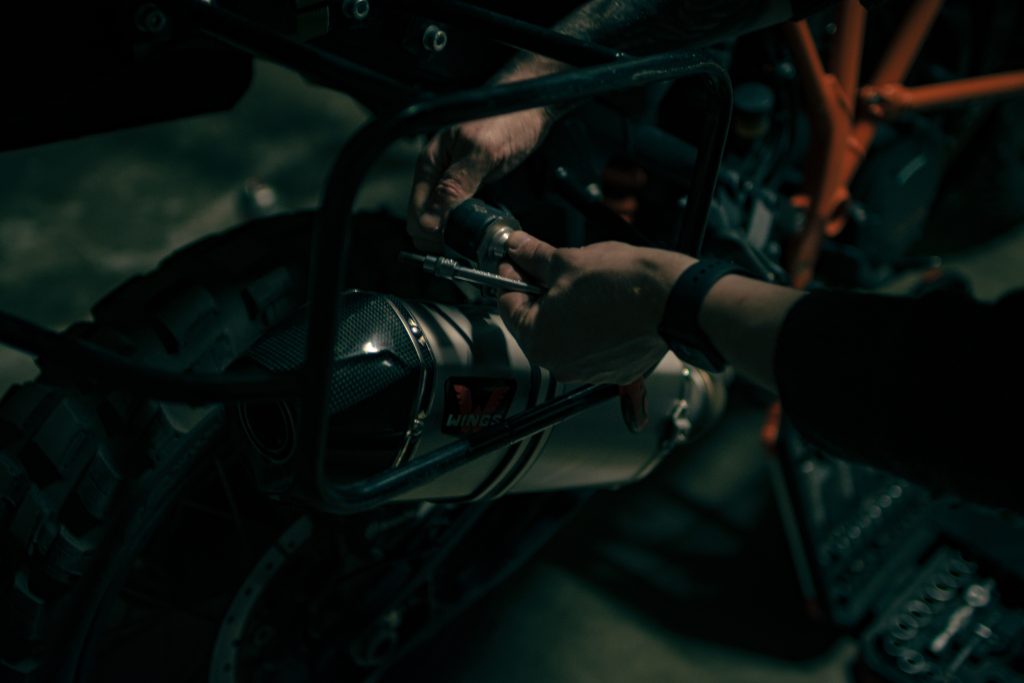
Determining the Sources of Heat in the Garage
To cool your garage effectively, you need to identify the sources of heat.
Identifying sun exposure
Firstly, consider the sun. If your garage is in direct exposure to sunlight, especially in the afternoons, it’s bound to heat up. Monitor the sun’s path in relation to your garage to understand if this is a significant factor.
Inspecting for lack of insulation
Next, inspect your garage for insulation. Insulation is essentially a barrier that slows down the transfer of heat. Without adequate insulation, a garage can quickly become a hotbox on summer days.
Evaluating current airflow and ventilation
Finally, consider airflow – good airflow can significantly bring down the temperature. A garage without proper ventilation can quickly become stuffy and hot, no matter what the outside temperature is.
Implementing Insulation to Keep Garage Cool
Proper insulation can do wonders in keeping your garage cool.
Different types of insulation
There are several types of insulation available – from fiberglass and foam board insulation to cellulose or spray foam. The choice depends on your needs, your budget, and your DIY skills. If you’re unsure, a local contractor or home improvement store can provide advice on what will work best for your garage.
How to properly install garage insulation
Depending on the type, installing insulation can be a straightforward DIY project or may need professional installation. Regardless, ensure that you’ve insulated not only the walls but also the garage door and windows, given these are places where heat can easily seep in.
Maintaining and checking insulation health
Insulation isn’t a set-it-and-forget-it thing. Its efficiency can deteriorate over time due to exposure to heat, cold, and moisture. Regularly checking for holes, gaps, or water damage and replacing as needed can ensure your insulation stays effective.

Improving Garage Airflow
Airflow plays a crucial role in maintaining the temperature and comfort of your garage.
The benefits of proper ventilation
Proper ventilation allows hot air to escape, pulling in cooler air and maintaining a more even, comfortable garage temperature.
Installing exhaust fans and vents
Installing exhaust fans and vents can significantly enhance airflow. While it’s a bit more of a challenge than some other solutions, the long-term benefits make it worthwhile.
Using portable fans and air movers
Portable fans and air movers are another great way to improve airflow. They’re more accessible than inbuilt vents and fans, are relatively inexpensive, and can be moved around the garage to direct the flow where you need it most.
Using Air Conditioning Units
If you spend significant time in your garage, using an air conditioning unit can be a suitable solution.
Choosing the right AC size for your garage
Choosing the right size of AC for your garage will depend on its size. An undersized AC will struggle to cool the space, while an oversized one can cause the unit to constantly turn on and off, contributing to wear and tear.
Portable vs built-in units
Portable units are easier to install and can be moved around. Built-in units generally offer better performance in larger spaces and can offer advanced features like programmable thermostats or energy-saving modes.
The cost-efficiency of using AC in a garage
While an AC is not the most cost-effective method to cool your garage, if you spend much time in there, the comfort it provides will likely outweigh the monetary expenses.

Natural Methods for Keeping Garage Cool
Apart from the above methods, there are natural ways to keep your garage cool.
Use of shade and trees
Planting trees or hanging a shade cloth can obstruct the direct sunlight that makes your garage feel like a furnace. Passive solar design using trees or other natural barriers can effectively combat sun-related heat gain.
Properly sealing garage doors and windows
Sealing the garage door and windows can help prevent warm air from sneaking in. Weather-stripping and caulking can do an excellent job in this respect.
Using reflective materials
Reflective materials can reduce heat absorption by reflecting the sun’s rays away from your garage. This can be achieved using reflective roofing, paint, or installing radiant barriers inside the garage.
Utilizing Dehumidifiers
Humidity can make a hot garage feel even hotter.
Benefits of a dehumidifier in a garage
Dehumidifiers can help by pulling water out of the air, which can make your garage feel cooler. They also prevent dampness, mold, and mildew that often come with high humidity levels.
Choosing the right type and size of dehumidifier
The right dehumidifier will depend on your garage size and the level of humidity. Look for one with enough capacity to handle your space, and consider features like timers or automatic shut-off for added convenience.
Positioning and maintaining your dehumidifier
Position your unit away from walls and furniture for maximum efficacy. Maintenance generally involves emptying the water reservoir regularly and cleaning it to prevent mold or bacteria build-up.
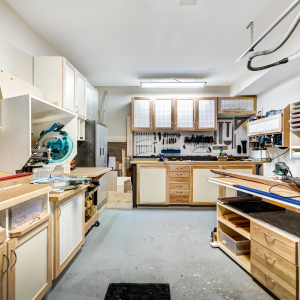
Avoidance of Heat-Generating Appliances
Some appliances can actually increase the temperature within your garage, making it hotter.
Typical appliances that generate heat
Think of things like refrigerators, freezers, or dryer vents. These appliances release heat while operating, which can add several degrees to your garage temperature.
Considerations for using these appliances in the garage
If you must keep these appliances in the garage, ensure adequate insulation and ventilation. Also, try to run them during cooler parts of the day or night.
Alternative options for appliance placement
If possible, relocate these appliances to a different part of your home or consider appliance-specific insulation or baffles to manage the heat they produce.
Maintenance and Continuous Improvement
Keeping your garage cool isn’t a one-time task. It demands regular maintenance and a program for continuous improvement.
Regularly monitoring garage temperature
Keep an eye on the garage temperature and humidity levels. Having this on your radar can alert you to any issues before they become bigger problems.
Checking on the effectiveness of cooling solutions
Regularly check on the effectiveness of your cooling solutions. For example, check your insulation and seals, clean your fans and vents, and service your AC unit as suggested by the manufacturer.
Making timely adjustments and changes to cooling strategy
As you monitor the temperature and the effectiveness of your cooling solutions, make changes as needed. Perhaps you need more fans, a different type of insulation, or maybe even a combination of cooling solutions. It’s all about finding what works best for your particular situation.
Cooling your garage can give you a more comfortable and versatile space. Whether it’s for your car, your hobbies, or your storage, a cool garage is indeed a valuable home asset.

